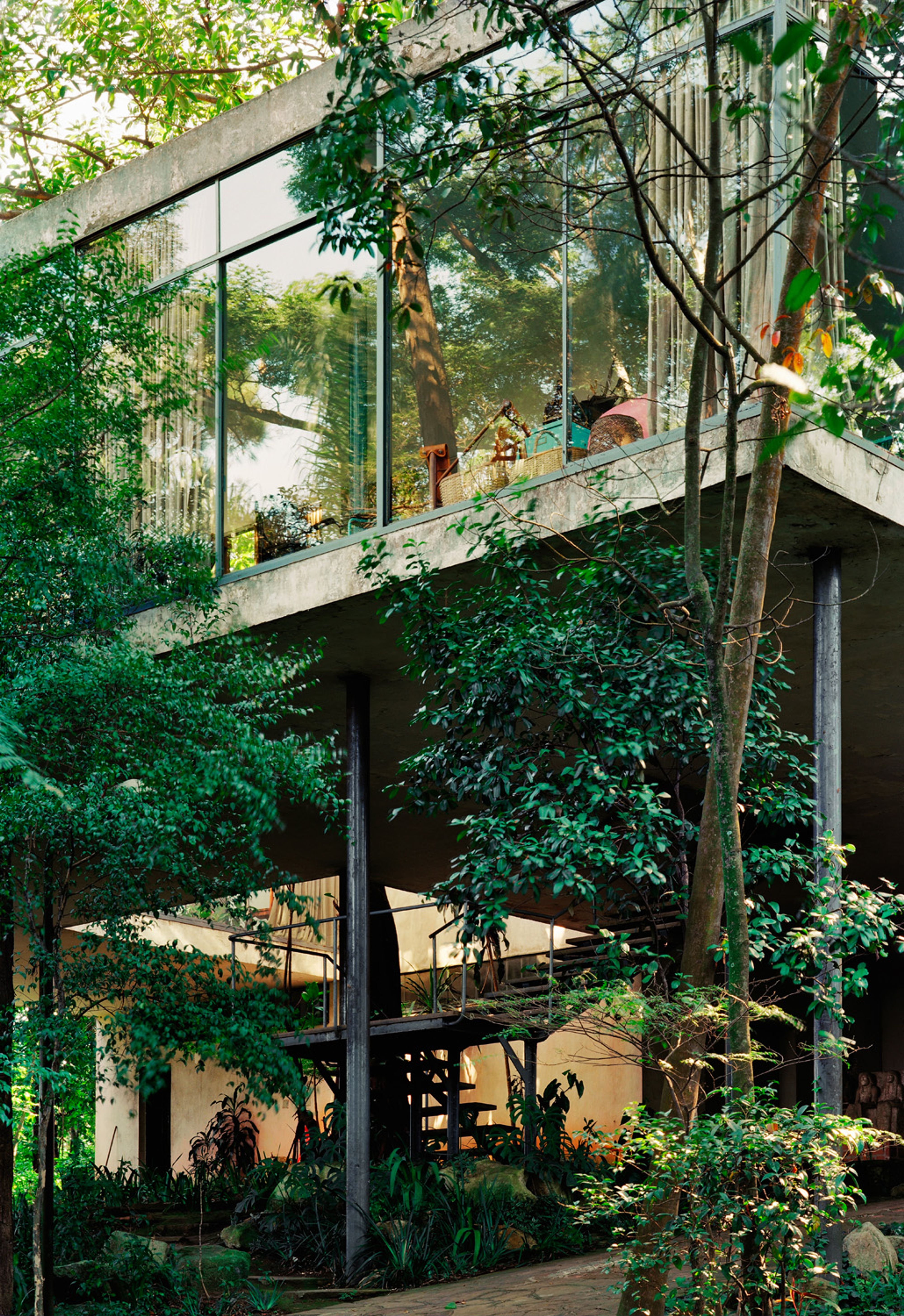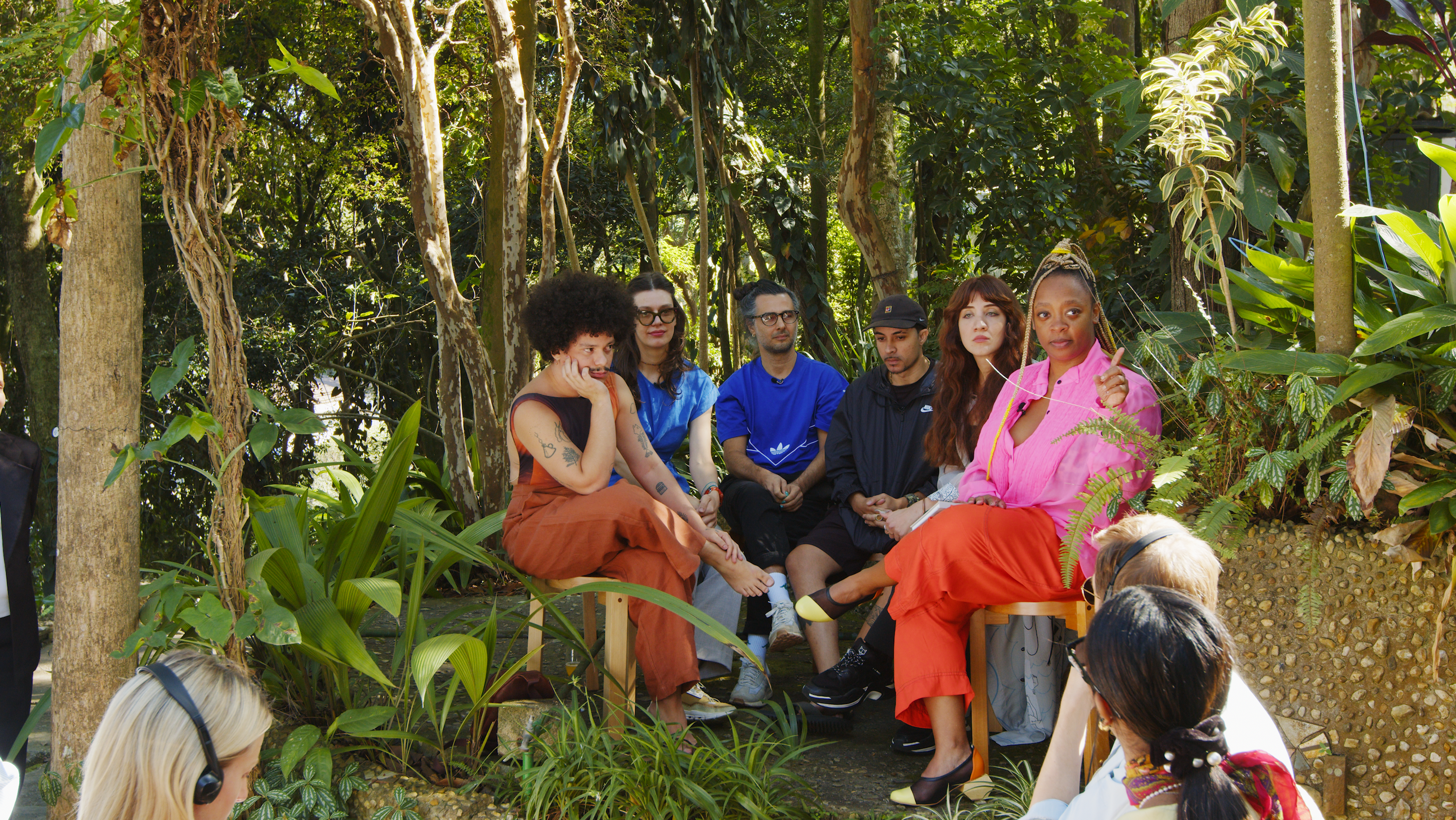
Bossa Nova legend Alaíde Costa. Photo courtesy of Bottega Veneta.

Bottega Veneta’s The Square at Lina Bo Bardi’s Casa de Vidro in São Paulo. Photo courtesy of Bottega Veneta.
As is the case with most historic house-museums, to find the Lina Bo Bardi Glass House in São Paulo you have to know exactly where you are going. The magic of the house-museum lies in the transgressions of privacy it invites. Building on this inherent exclusiveness, Bottega Veneta staged its third iteration of The Square, a semi-seasonal cultural program conceived by the brand’s creative director, Matthieu Blazy, in the 1950’s masterpiece of Brazilian modern architecture. Taking the Glass House’s Italian-born, Brazilian architect as its spiritual center, the exhibition and programs curated by Mari Stockler filled Lina Bo Bardi’s former home with works by living artists across generations, mediums, and distinct Brazilian communities. On a beautifully temperate late May morning, guests from around the world made their way past the parakeet green gate of 154 Rua General Almério de Moura and up the steep and winding stone-pathed path in the residential neighborhood of Morumbi. At the top of the hill, thin pale blue pilotis rise from the dirt to support the gorgeously simple reinforced concrete house, with its iconic ribbons of glass framing the ever-expanding canopy of trees that surround it and even rise through its center courtyard.

Lina Bo Bardi’s Casa de Vidro in São Paulo. Photo courtesy of Bottega Veneta.
Without explicit wall labels or credits, dozens of artworks were exhibited throughout the house and extended property. Especially powerful were the moments of ambiguity, little to no distinction between what was introduced by the curator and what is from the private collection of Bo Bardi and her husband, art critic and journalist Pietro Maria Bardi. Some of the works on display for The Square, like visual poetry by Augusto de Campos, the founder of the Brazilian Concrete poetry movement, must have been familiar to Bo Bardi, who herself was a cultural star and center of an artistic milieu. Others, like a photograph of the back of a young man's head showing off an ingenious hair style that involves cutting holes through plastic to create a mesmerizing grid of bleached spots, are very recent works that speak to the continuum of powerful and valid contributions of Brazilian communities that suffer from the country’s infamous class divide. The photograph, entitled Encosta (2021) is by Rio de Janeiro artist, gallerist, and organizer, Allan Weber. Visiting from the favela Brás de Pina where he also runs his gallery, 5 Bocas, Weber roamed the haphazardly forested garden before sitting down to participate in the day’s events.

Bottega Veneta’s cultural program The Square. Photo courtesy of Bottega Veneta.
Enforcing the curatorial structure of the exhibition’s four pathways, the opening event consisted of talks around four themes: time, geometry and spirituality, Brazilian counterculture, and the roots of Bossa Nova. Led by powerful moderators like multi-hyphenate cultural practitioner Keyna Eleison and the always-lyrical curator Daniel Rangel, the days’ programming fed off of the intimacies afforded by a luxurious setting –– conversation becomes entertainment and the seam between what is staged (placed product) and what is personal style is lost. While attended by celebrities, journalists and influencers beyond the Brazilian scene, the conversations –– conducted in Portuguese and live-translated into English for international guests –– remained focused on national contributions to global topics such as ecology, decolonization and Afro-futurism. The final act transcended language anyway, as the croning and scat-singing of Bossa Nova legend Alaíde Costa brought the room to tears. Some of this effect can be attributed to Blazy’s unique touch. He insists on a dedication to localism, and for this he should be commended –– it takes humility to let craft speak for itself.

Bossa Nova legend Alaíde Costa. Photo courtesy of Bottega Veneta.

Bottega Veneta’s creative director, Matthieu Blazy. Photo courtesy of Bottega Veneta.
Along one of the four concrete pillars of the center courtyard was a work by Lenora de Barros titled Poema (1979). Six black and white photographs arranged in a vertical cinematic sequence –– the top one a sensual crop of a woman’s mouth, the bottom photo showing all the strikers of a typewriter engaged in a violent single action, and in between, three unforgettable iconic photographs of the artist’s tongue making its way across the typewriter's chiclet-like ergonomic keys. I couldn’t help but think about Bottega’s iconic intrecciato weave and how, on more than one occasion, I found it nearly delectable enough to run my tongue across. However brief Bottega’s landing in Brazil, the impression it left aligned delicately with the country’s unique and not-easily-summarized aesthetic offerings.

Bottega Veneta’s The Square at Lina Bo Bardi’s Glass House.